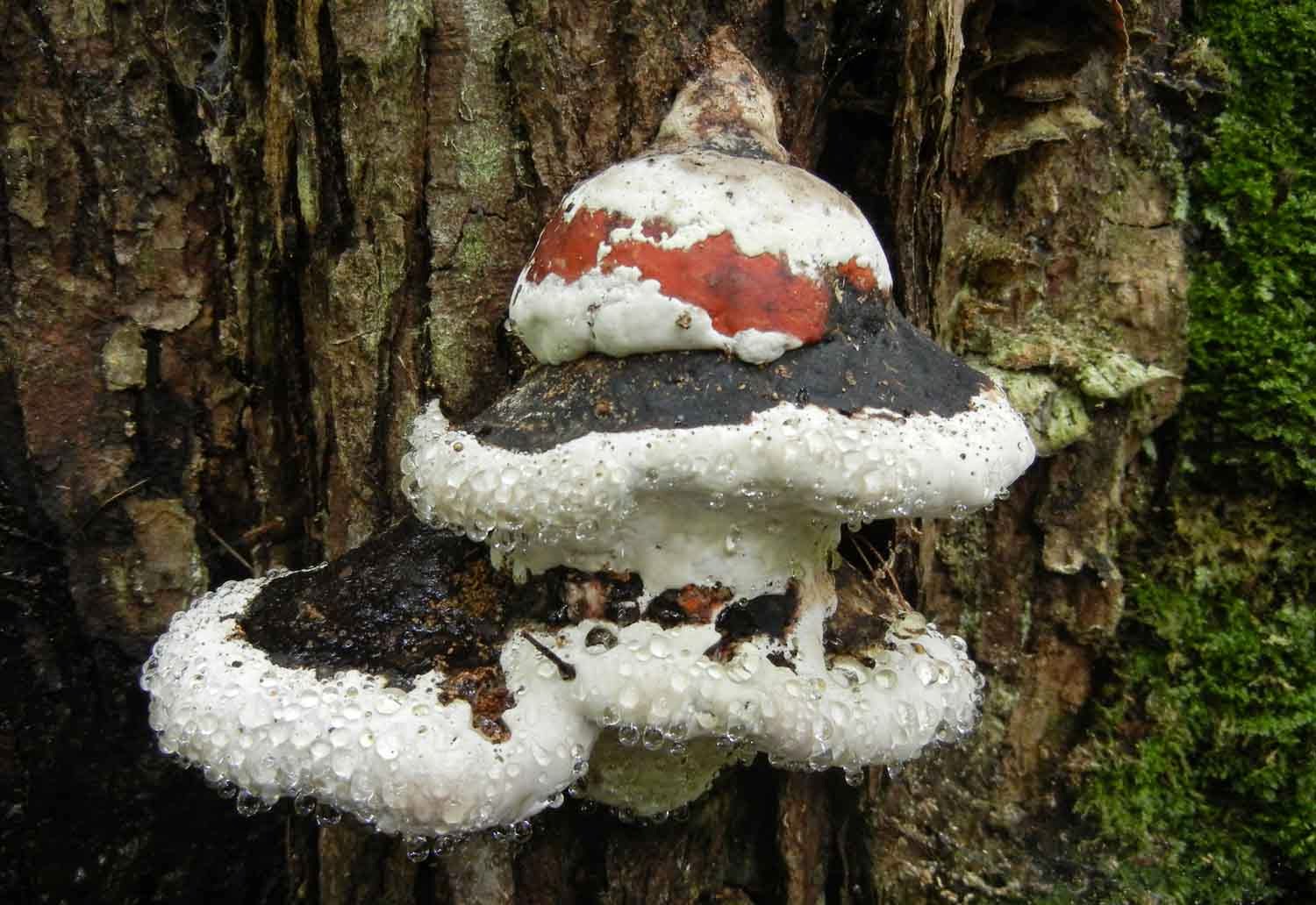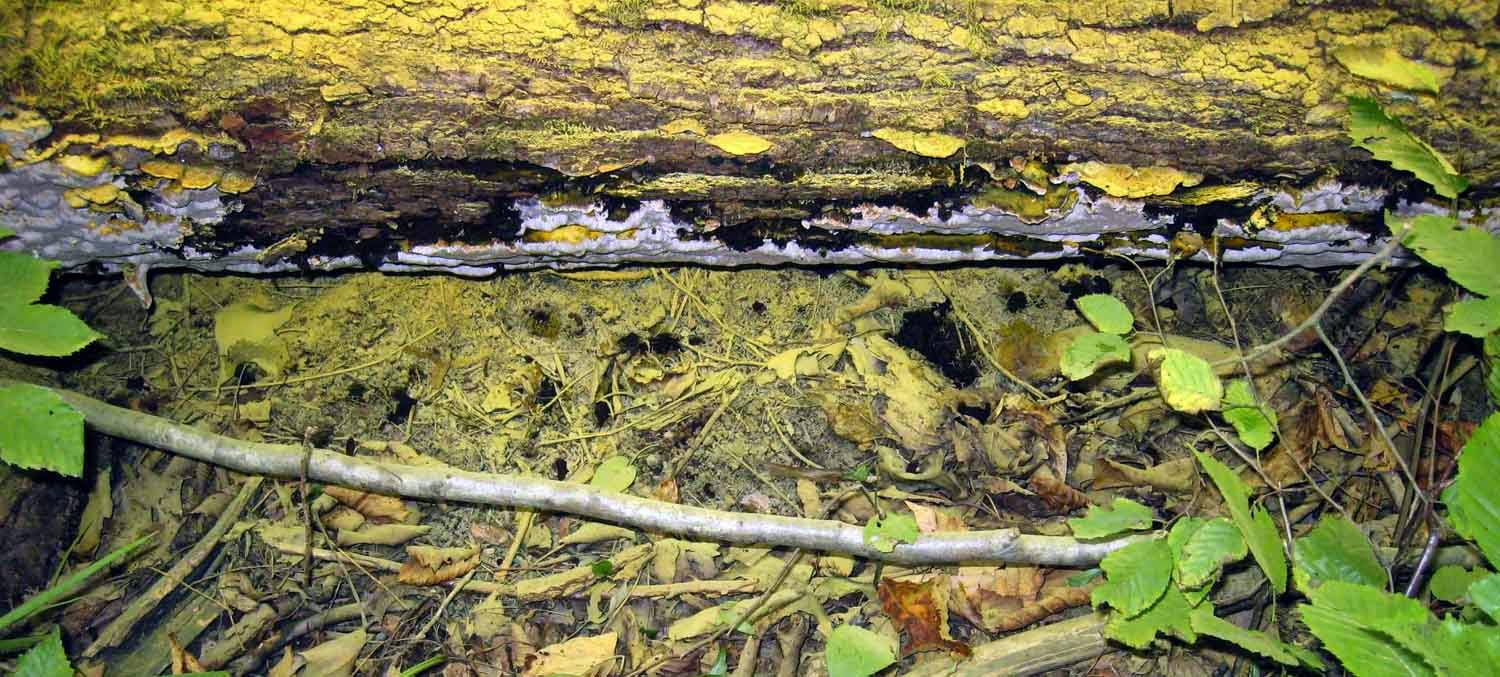 |
| Young Red-Belted Polypore (Fomitopsis pinicola) with guttation drops |
Some fungi are prone to exhibiting a curious phenomenon—they exude beads of moisture, called guttation. In several polypores, such as Fomitopsis pinicola, the liquid produced can look so much like tears that you'd swear the fungus was weeping. Or maybe sweating. Other species produce pigmented drops that can look like milk, or tar, or even blood.
Guttation is more well-known in some vascular plants. During the night, when the plant's transpiration system is shut down, pressure from excess moisture in the roots can force beads of sap out of special structures on leaf edges.
 |
| Guttation droplets on strawberry leaves (Noah Erhardt/Wikipedia) |
In fungi, the guttation mechanism is not so well understood. In many species, however, it's so often observed, particularly during times of rapid growth when temperature and humidity are favourable, that these beads of liquid can be a reliable macroscopic characteristic. Hydnellum peckii, for instance, so frequently "bleeds" pigmented drops in its early stages of growth that it's been given gruesome nicknames, including "Bleeding Tooth Fungus" and "Devil's Tooth." Coincidentally, a 1965 study found a compound in the fruiting body of H. peckii that has anticoagulant properties similar to those of heparin, too much of which can make one bleed to death internally.
 |
| Bleeding Tooth Fungus (Hydnellum peckii) produces red-pigmented guttation droplets during periods of rapid growth. (Lisa Neighbour) |
A couple of years ago, I came across a crop of Inonotus glomeratus on a maple log. I'd found this amazing polypore a few times, once right after it had showered itself, and everything else around it, with millions of sulphur-yellow spores. The one I'd found, though, was very young, and instead of spewing spores, it was weeping globules of "tar" in copious enough amounts that shiny black pools were accumulating on the forest floor. Unlike most guttation drops, which are watery, these exudations were thick and sticky and stained my finger and thumb a deep auburn brown. And kind of glued them together. Oddly, though this unusual guttation has been noted by others, there seems to be no mention of it in the literature. I. glomeratus is so unusual in so many ways, I ended up writing a whole post about it.
 |
| Fast-growing Inonotus glomeratus produces tarry guttation. |
 |
| This Inonotus glomeratus continued to drip its viscous black exudate even after it began releasing its yellow spores. |
 |
| The guttation drops on this Inonotus glomeratus were so thick that the fungus grew around them, producing a pitted appearance after rain washed them away. |
Polypores and Hydnoids are not the only fungi to produce guttation. In moist conditions, young Suillus americanus stipes can be heavy with yellow-tinted drops. Guttation is also common enough in the uncommon Rhodotus palmatus that this characteristic is often included in descriptions.
 |
| Chicken Fat Suillus (Suillus americanus) |
 |
| Wrinkled peach (Rhodotus palmatus) |
Guttation can happen in incredibly small ways, too. During the Toronto Bioblitz a few years ago, we found some Lachnum subvirgineum that, despite what seemed like dry conditions, were covered in minute guttation droplets, as were most other Lachnum I've since come across.
.jpg) |
The largest of these Lachnum subvirgineum was less than .5 mm. in
diameter, which makes the guttation droplets impressively small.
|
Another minute character is so characteristically bejewelled in guttation droplets, it's named for it: Pilobolus crystallinus, which is one of the "Cannon" or "Hat Thrower" fungi found on herbivore dung.
 |
| Dung-loving Pilobilus crystallinus, is named for its sparkling guttation droplets. (See my post about this remarkable, tiny fungus, also called Hat Thrower, or Cannon Fungus) |
Or have different species evolved to produce guttation droplets for different purposes? The edible bolete, Suillus bovinus, for instance, has been shown in the lab to reabsorb nutrients from its guttation droplets, while leaving behind less useful byproducts, such as oxalic acid. So perhaps guttation has evolved as an efficient method of expelling waste for some fungi.
Is that what's going on with Inonotus glomeratus? Is that viscous, black ooze just a collection of rejected metabolic byproducts? If anyone would like to analyze it and has the means, I have some dehydrated exudate that I'd love to send you!
 |
| Even some slime moulds, like this immature Stemonitis flavogenita, produce guttation droplets. (Ulrike Kullik) |
 |
Pink-pored Fomitopsis rosea are even prettier when
decorated with shimmering beads of moisture. I think the pattern on rim was made by the "teeth" of a grazing slug. |
 |
| Early nubbins of an unidentified polypore exude milky drops. |
 |
| This Red-belted Polypore (Fomitopsis pinicola) produced guttation droplets for three months one summer. When it finally stopped, trompe l'oeil teardrop-shaped indentations were left behind. |
 |
| Wet weather makes Xylaria hypoxylon produce beads of moisture. |
 |
| This large Pleurotus dryinus was weeping copiously despite there having been no rain for a week. |
 |
| Many parasitic Hypomyces, such as this H. chrysospermus, are prolific weepers. |
 |
| Inonotus dryadeus is a lumpy polypore known for its ample production of amber guttation droplets. (Wikipedia) |
 |
| The Jack-o-lantern Mushroom (Omphalotus illudens) not only glows in the dark, it also produces orange-staining guttation. |
 |
| The Resinous Polypore, (Ischnoderma resinosum), is also named for the droplets it produces when very young. |
 |
| The reddish-rimmed gills of this group of Mycena leaiana produced tiny white droplets. |
 |
| Even the hairy asexual form of Postia ptychogaster produces guttation. |
Selected References:
Hutwimmer, S., Wang, H., Strasser, H., Burgstaller, W. (2010) Formation of exudate droplets by Metarhizium anisopliae and the presence of destruxins.Mycologia, Vol. 102 no. 1, 1-10
Gerhard Saueracker. On the Exudates of Polypore Fungi. Fungimap Newsletter 48, Jan. 2013
(NB: This is a slightly edited repost from my other blog: Weird & Wonderful Wild Mushrooms
Gerhard Saueracker. On the Exudates of Polypore Fungi. Fungimap Newsletter 48, Jan. 2013
(NB: This is a slightly edited repost from my other blog: Weird & Wonderful Wild Mushrooms
.jpg)
No comments:
Post a Comment